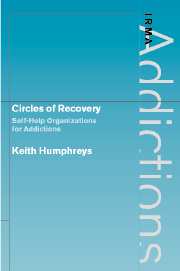Book contents
- Frontmatter
- Contents
- Acknowledgements
- 1 Definitions, scope, and origin of the health-related self-help group movement
- 2 An international tour of addiction-related mutual-help organizations
- 3 Does self-help group participation lead to positive addiction-related, psychiatric, and medical outcomes?
- 4 A different perspective on change in self-help organizations: spirituality, identity, life stories, friendship networks, and politicization
- 5 How should government agencies, healthcare organization, and clinicians interact with self-help organizations?
- Epilogue: summing up, moving forward
- References
- Index
2 - An international tour of addiction-related mutual-help organizations
Published online by Cambridge University Press: 31 July 2009
- Frontmatter
- Contents
- Acknowledgements
- 1 Definitions, scope, and origin of the health-related self-help group movement
- 2 An international tour of addiction-related mutual-help organizations
- 3 Does self-help group participation lead to positive addiction-related, psychiatric, and medical outcomes?
- 4 A different perspective on change in self-help organizations: spirituality, identity, life stories, friendship networks, and politicization
- 5 How should government agencies, healthcare organization, and clinicians interact with self-help organizations?
- Epilogue: summing up, moving forward
- References
- Index
Summary
Background and context
The modern self-help group movement comprises many addiction-related organ izations for all the reasons detailed in Chapter 1. Substance abuse is a chronic behavioral health problem and sufficiently prevalent to provide a large pool of potential self-help organization members. It cannot be addressed solely by professional resources because, as a stigmatized condition, it rarely commands a significant share of healthcare budgets, and, even when it does, many professionals do not know how, or simply do not want to, treat it. And in any case, many addicted individuals wish to change in ways that are hard to achieve with professional services alone, for example by building a new community that supports recovery.
These realities make it conceivable that addiction-related groups are the most common type of self-help organization. Support for this conjecture includes data showing that more than half of health-related self-help groups in the city of Hamburg, Germany, focused on substance abuse (Deneke, 1983). The only detailed national information on this question comes from the USA, where mutual-help group attendance is far more common than in other nations for which national data are available (e.g., Canada, see Gottlieb & Peters, 1991), and perhaps particularly so for addiction-related groups (Mäkelä et al., 1996). With that caution, the following nationally representative survey data, gathered by Ronald Kessler et al. (1997), is worthy of consideration. Of US adults aged 25–74 years, 18.7% had attended a self-help group in their lifetime, and 7.1% had done so in the past 12 months.
- Type
- Chapter
- Information
- Circles of RecoverySelf-Help Organizations for Addictions, pp. 33 - 93Publisher: Cambridge University PressPrint publication year: 2003



